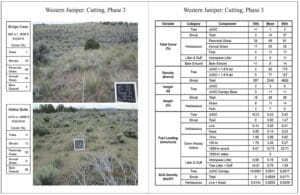View the guide.
This guide is intended to help land managers better understand the variability in long-term responses of fuel loads and vegetation to woody-plant reduction treatments in the Intermountain West. It pairs photographs of sagebrush and pinyon-juniper treatments with fuel loading and plant height, cover, and density data (fig. 1).
The guide is split into sagebrush and pinyon-juniper sections, and further subdivided by region, woodland development phase or sagebrush groups, and treatment type. The sagebrush section includes the following treatments: mowing, herbicide application (tebuthiuron), prescribed fire, and an untreated control. The pinyon-juniper section includes cutting, prescribed fire, and an untreated control for each region, and an additional mastication treatment for the Utah Juniper region.
There are few resources for land managers that depict the long-term responses to fuels treatments in the Intermountain West, making this guide unique. Fuel beds change substantially from the early years after treatment to ten years down the road; shrub and herbaceous fuels recover, while duff, tree litter, and fine down woody debris decompose. Fire behavior specialists and fuels managers can use the fuels guide to quickly estimate fuel loads in the field, and use the data in fire behavior modeling and fuels treatment planning. Although hard copies are not currently available, the guide can be used on a tablet in the field, or a subsection can be printed. The photographs in the guide provide a wealth of information, and could be used by students or new land managers for a better understanding of long-term vegetation recovery after a disturbance.
Click on image to get a closer look
 Figure 1. This example layout includes cutting treatment in Phase 3 in the western juniper region. In the photographs, notice that cut tree skeletons are still intact, and that the shrubs and grasses have largely recovered. Left of the photographs is cover data by plant functional group describing the plot in the photograph. The right side of the layout summarizes data (for all cutting plots in the Phase 3 development of the western juniper region) including: cover by functional group, tree and shrub density, height by functional group, fuel loads, and bulk density. The mean, 10th percentile, and 90th percentile are displayed to show the range in variability of the data.
Figure 1. This example layout includes cutting treatment in Phase 3 in the western juniper region. In the photographs, notice that cut tree skeletons are still intact, and that the shrubs and grasses have largely recovered. Left of the photographs is cover data by plant functional group describing the plot in the photograph. The right side of the layout summarizes data (for all cutting plots in the Phase 3 development of the western juniper region) including: cover by functional group, tree and shrub density, height by functional group, fuel loads, and bulk density. The mean, 10th percentile, and 90th percentile are displayed to show the range in variability of the data.
